|
The
|
|
THE BURGENLAND BUNCH NEWS - No. 347 October 31, 2023, © 2023 by The Burgenland Bunch All rights reserved. Permission to copy excerpts granted if credit is provided. Editor: Thomas Steichen (email: tj.steichen@comcast.net) BB Home Page: the-burgenland-bunch.org BB Newsletter Archives: BB Newsletters BB Facebook Page: TheBurgenlandBunchOFFICIAL Our 27th year! The Burgenland Bunch Newsletter is issued monthly online. The BB was founded in 1997 by Gerald Berghold, who died in August 2008. |
|
| Current Status Of The BB: * Members: 3195 * Surname Entries: 9308 * Query Entries: 5931 * Staff Members: 14 |
|
| This newsletter concerns: 1) THE PRESIDENT'S CORNER 2) HISTORICAL BB NEWSLETTER ARTICLES: - THE RIGHT OF DOMICILE 3) ETHNIC EVENTS 4) BURGENLAND EMIGRANT OBITUARIES (courtesy of Bob Strauch) |
|
1) THE PRESIDENT'S CORNER (by Tom Steichen)  This
month's random bits and pieces (Article 1) begins This
month's random bits and pieces (Article 1) begins
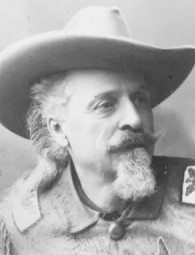 with
a new mug shot of me. The previous one was from 2020. Since then I've gone through a full Santa beard and
am now into a Buffalo Bill Cody look (so-called by my wife, though I do not turn up the ends of my
moustache like he did!). Given my attendance at the Delegation Visit and resulting public visibility, I
figured it was time to admit to the new look. with
a new mug shot of me. The previous one was from 2020. Since then I've gone through a full Santa beard and
am now into a Buffalo Bill Cody look (so-called by my wife, though I do not turn up the ends of my
moustache like he did!). Given my attendance at the Delegation Visit and resulting public visibility, I
figured it was time to admit to the new look. Speaking of the Burgenland government Delegation Visit, I begin the textual tidbits with a few items related to that. We follow with a pair involving the ancient Amber Road, the first being about the association involved in preserving the Roman Amber Road and the second about what appears to be a (modern) distance marker along that road. From there, I ask Where is Alliance, PA? Do you know? Then we talk about a DNA study that reveals that Humans Faced Extinction Nearly A Million Years Ago. I close with a partial Trip Report by Joy Mins that discusses the possible Croatian original village of her Burgenland ancestors. Our regular tidbits include the monthly BB Facebook report, book sales, a recipe and some Words For Thought. The remaining articles are our standard sections: A Historical BB Newsletter article, Ethnic Events and Emigrant Obituaries. Burgenland Government Delegation Visit: A Burgenland government delegation visited four locations in North America in October: Toronto October 16-18, Chicago October 18-19, Lehigh Valley Oct 19-21, and New York Oct 21-23. 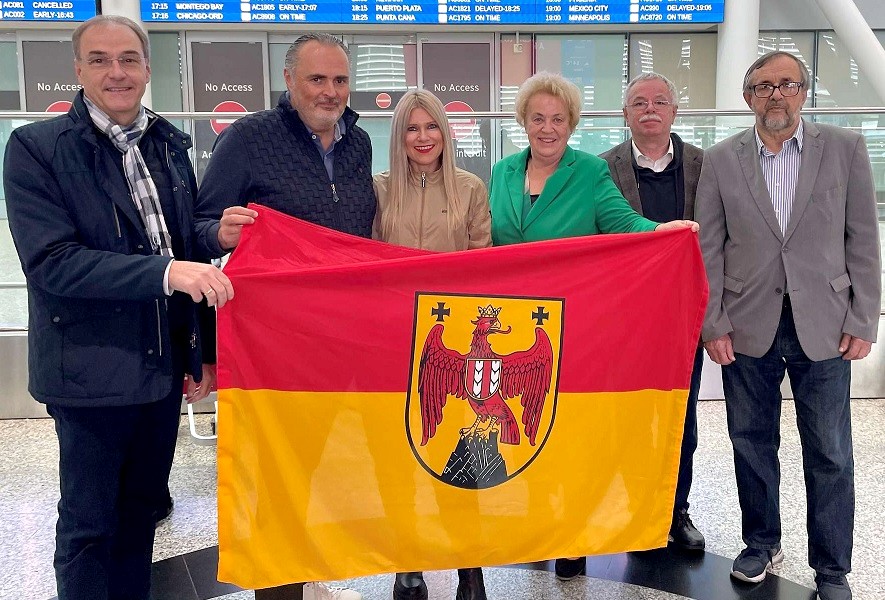 The delegation (left to right) consisted of Leonhard Schneemann, member of the government (Social and Economic councilor); Hans Peter Doskozil, governor of Burgenland, and his wife Julia; Verena Dunst, former president of the Burgenland parliament (and husband Manfred, not shown); Klaus Gerger, BG and vice president of Burgenland-Bunch; and Erwin Weinhofer, vice president of the BG. They were accompanied by support personnel (not shown) Christian Stiller, deputy office manager and press spokesperson for the office of the governor; Manfred Riegler, chief of protocol; Maria-Anna Slaby, member of the protocol office; and Paul Blaguss, from the Blaguss travel agency. In a press release, the governor's office referenced the recent 100th anniversary of Burgenland and noted that the aim of the current visit was to open a new chapter in maintaining contact with the emigrant Burgenland community, furthur noting that the first such trip took place in 1971 on the occasion of the 50th anniversary of Burgenland. He wants to enable a constant exchange, saying, "The aim is to create new offers in areas such as culture, education and business, also for younger generations. Networking with the Burgenland University of Applied Sciences and the Joseph Haydn Private University's 'Artist in Residence' projects and a constant flow of information, including social media, about current developments in the country can be valuable for both sides." As for events in North America, Toronto held a "meet Burgenländers" gathering on the evening of the 17th at the Burgenländer Club Toronto. In Chicago, there was a by-invitation dinner involving BG and Jolly Burgenländer club members with the delegation. The Lehigh Valley held a goulash dinner for the delegation and a public "meet Burgenländers" event at the Coplay Sängerbund, both sponsored by the Sängerbund Heritage Committee. I attended the public event and was able to meet the delegation members and talk with all of them. The Governor took great glee in introducing to me his fellow delegation member, Leonhard Schneemann, as Snowman, as that is the English translation of Leonhard's surname. Also, the Governor ended his address to the gathering by noting (with a big smile) that he will need to "send his mother to the Lehigh Valley" to learn to make a proper goulash, which earned chuckles all around the room! 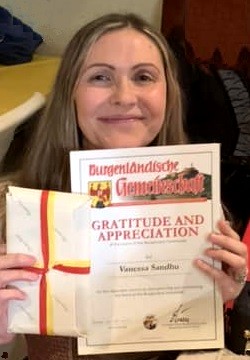 The
US-based BB staff members in attendance (Bob Strauch, Vanessa Sandhu, Zac Stubits and myself) were honored with
certificates of gratitude and appreciation by the BG and the delegation, as well as small gifts (more on this
in the next bit). I greatly enjoyed this opportunity to meet many BB and BG members... but I was sad that I missed
out on the homemade baked goods, as I simply talked too much to find time to enjoy any! The
US-based BB staff members in attendance (Bob Strauch, Vanessa Sandhu, Zac Stubits and myself) were honored with
certificates of gratitude and appreciation by the BG and the delegation, as well as small gifts (more on this
in the next bit). I greatly enjoyed this opportunity to meet many BB and BG members... but I was sad that I missed
out on the homemade baked goods, as I simply talked too much to find time to enjoy any! Klaus Gerger, our BB VP, was a part of the delegation representing the BG. Earlier in the day, my wife and I met Klaus in Bethlehem for brunch and a tour around town to see the Moravian historical sites there. Among our stops, we visited a reconstructed Moravian blacksmith shop where we talked with the interpreter/guide there. Klaus happened to ask the guide where his ancestors were from, and the answer was Austria. Klaus then asked where in Austria, and the answer was Güssing, which caused Klaus to exclaim, "I'm from Güssing!" Of course, Klaus recognized the guide's family name and much back-slapping and pictures followed, and the whole experience became a story that he told that evening at the delegation dinner, much to the delight of the whole delegation. My wife and I also enjoyed dinner that evening with Zac Stubits and wife Jessica. This was my first opportunity to meet Zac in person and we were able to talk much about the BB and our personal lives. Our other BB staffers, Bob, Vanessa and Klaus, were part of the delegation dinner, Klaus as a delegation member and Bob and Vanessa as part of the Heritage Committee. In New York, the public event was a Katharinenball in the grand ballroom at the Plattduetsche Park Restaurant on October 22. This was also the 100th Anniversary Gala for the First Burgenländer Association of New York. Gifts From The Delegation: I mentioned above that the 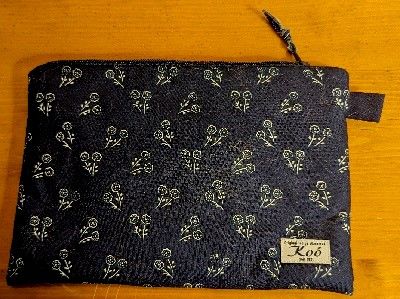 certificates of
gratitude and appreciation were accompanied by small gifts, which each proved to be a small, padded
cloth bag in the deep blue produced by Blaudruck Koó, the indigo print shop of Josef and Miriam Koó in
Steinberg, Burgenland. This shop has been in existence since 1921 and still produces material using the
traditional, small-scale, by-hand techniques via equipment developed by Josef's grandfather. It is one of only two
shops in Austria that still hand-produces printed cloth with natural vegetable-based indigo dye, a tradition that
dates back to ancient times. certificates of
gratitude and appreciation were accompanied by small gifts, which each proved to be a small, padded
cloth bag in the deep blue produced by Blaudruck Koó, the indigo print shop of Josef and Miriam Koó in
Steinberg, Burgenland. This shop has been in existence since 1921 and still produces material using the
traditional, small-scale, by-hand techniques via equipment developed by Josef's grandfather. It is one of only two
shops in Austria that still hand-produces printed cloth with natural vegetable-based indigo dye, a tradition that
dates back to ancient times.Strictly speaking, indigo printing actually consists of dyeing white cloth that has had a pattern printed on it with a paste that resists uptake of the dye, allowing the pattern to remain after dyeing. The paste is applied onto the fabric using old wooden printing blocks or rollers and washed out again after dyeing is complete. As a result, a pattern in white appears against a blue background. Once printed, the fabric needs to cure for around five weeks before dyeing. The exact recipe for the paste has always been a well-guarded secret of every indigo printer. Each printer had his own special recipe which was passed from generation to generation, but always include gum-arabic and clay. Depending on the desired intensity of the blue hue, the dyeing procedure can take many hours, as the fabric is dunked multiple times into a dye bath of water, indigo and lime and then allowed to partially air dry between dunking cycles. The dyed cloth is pale yellow when removed from the first bath and takes on a blue hue as oxygen is absorbed by the wet dye. Subsequent baths lead to greenish colors that become progressively deeper blue with additional oxygen uptake. In former times, these indigo print fabrics were used in Burgenland for clothes of everyday life and work. Blaudruck Koó's specialty is making double-sided material showing a different pattern on each side. As they explain, in the early days washing laundry was an exhausting business, so it was very convenient to be able to use both sides of an item (harking back to last month's Grandma's Apron tidbit, I can imagine a two-sided apron, ready to be quickly reversed to show the clean side... and I see that Blaudruck Koó sells such two-sided aprons in their online shop!). Today, their cloth is mainly used for producing traditional dress wear and for artistic specialty items that celebrate the ancient craft of indigo printing. And they make excellent delegation gifts! Amber Road Association Elects New Chairman: The Association for the Preservation of the Roman Amber Road has a new chairman, Oswald Gruber from Lutzmannsburg. Gruber would like to bring the history and significance of the Amber Road closer to people. The association has existed since 1989 and currently has 95 members. The 2,000-year-old Amber Road once served as an important travel and trade route, stretching from the Baltic Sea to the Mediterranean. “The fascinating thing is that we can learn from all periods of history through the finds we make along the Roman Amber Road. We can also show these finds. This is history that can be experienced and touched,” said Gruber. Communication is important to the historian and geographer, as he used to teach at the Oberpullendorf high school. As the new chairman, he wants to break new ground and intensify cooperation with the state, communities, schools and kindergartens. Lectures and excursions are planned. Together with the state of Burgenland, there are also plans to document the Roman settlement and military camp in Strebersdorf, says Gruber. Next year, the 35th anniversary of the Association will be celebrated and will include an excursion to the remains of Roman Scarbantia in Sopron. A Confusing Marker: For the tidbit above, I searched for an image that might go with the text. While I did not find one for that purpose, I thought I would talk about part of an image I found during that search, as it was rather confusing! The image was taken in the Fő tér (Main Square, which was adjacent to the Roman Amber Road) in Sopron, Hungary, and included a marker embedded in the paving that I show below: 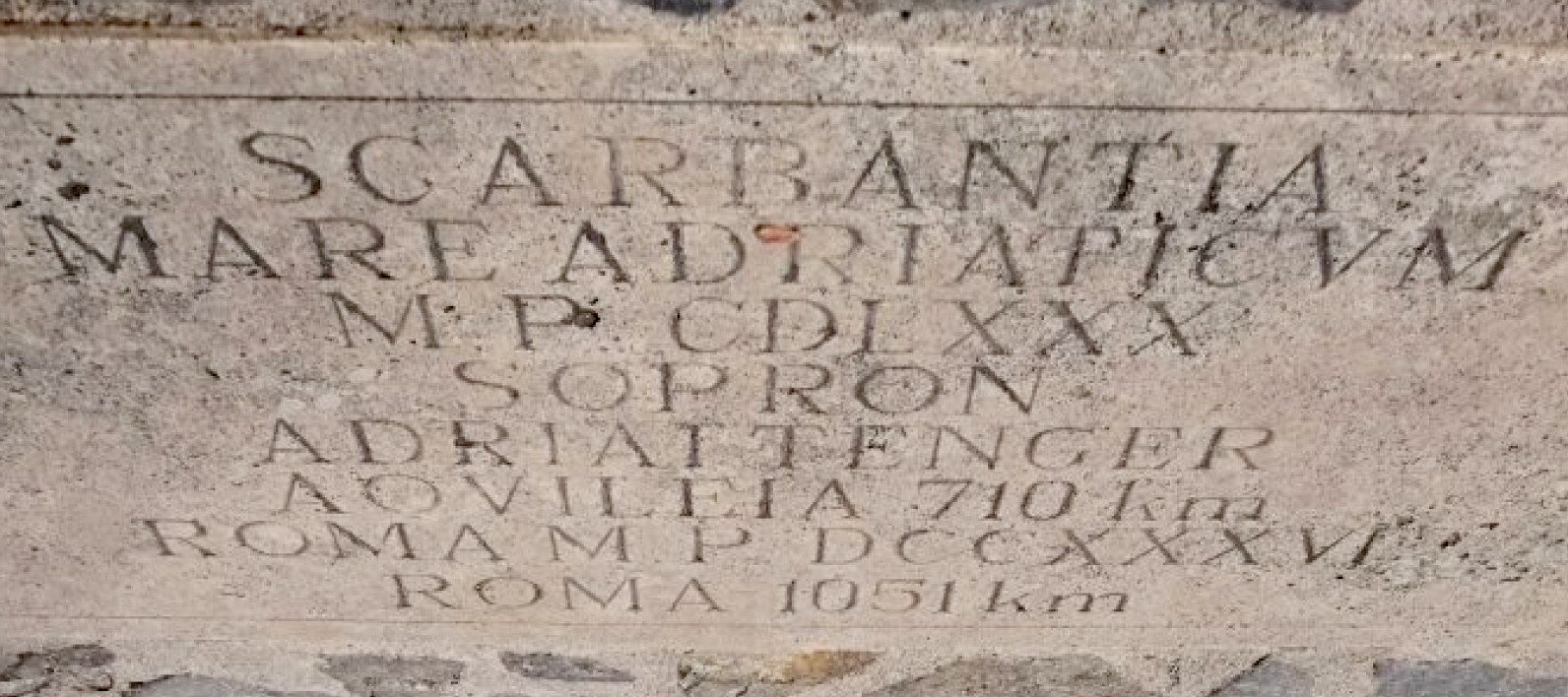 The "marker" was facing away in the image, so I've rotated it, and the camera was not focused down onto the marker, so we get the typical perspective shrinking of the text that was further away, but I think it remains readable. Let me extract each line for you and give you my initial interpretations. - Scarbantia was the name the Romans gave to their town on the site that eventually became Sopron. - Mare Adriaticum is Latin for Adriatic Sea. - M P CDLXXX is Latin for 480 miles (these miles, of course, are Roman, not US miles). - Sopron is the Hungarian name for their town on the site of ancient Scarbantia. - Adriattenger is Hungarian for Adriatic Sea. - Aquileia 710 km is the name of an Italian town near the Adriatic Sea and what I assume is its (approximate) distance (710 km) from Sopron. - Roma M P DCCXXXVI is Rome (Italy) and its (approximate) distance from Sopron, with distance expressed as Roman miles (I'll skip evaluating that number for now). - Roma 1051 km is again Rome (Italy) but with its (approximate) distance from Sopron expressed in kilometers. OK, I said I was confused by this marker, so let me explain my confusion. First, one can express Roman distances in kilometers by knowing that an Imperial Roman mile was standardized by Agrippa in 29 BC, and that Agrippa's Imperial Roman mile has been empirically estimated to be about 1.48 kilometers. So, for example, multiplying 480 Roman miles by 1.48 yields 710 km (rounded to the nearest kilometer). Thus the 710 km on the line with Aquileia seems to make sense... or does it? I'd presume that the 480 Roman miles (710 km) was intended to be the distance from Scarbantia to the Adriatic Sea, so why wasn't the 710 on the Adriattenger line rather than Aquileia? Admittedly, Aquileia is only about 9 km from the Adriatic Sea shore... but still! One possible way to resolve this is to join the two lines together, to get Adriattenger Aquileia 710 km (which we might read to mean Aquileia on the Adriatic Sea). But there is a bigger problem... if you look at modern road maps and pick a route that goes through towns known to have been on the Roman Amber Road (Carnuntum, Sopron, Szombathely, Ptuj, Celje, Ljubljana, Aquileia, Venice and Rome), the distance from Sopron to Aquileia is estimated (by GoogleMaps) to be just 467 km, not 710! While it is not relevant to my argument, if you convert 467 km to Roman miles (= 467/1.48), you get 316 (= CCCXVI), not 480, numbers that are not approximately equal. Let's set this aside for a moment and jump to the last line, where it seems probable that 1051 km is supposed to be the distance from Sopron to Rome. If you continue the trip from Sopron to Aquileia onward to Rome, the total distance from Sopron to Rome is estimated by GoogleMaps to be 1077 km. This seems close enough to 1051 not to question that number, as we do not know that GoogleMaps picked the exact route of the Amber Road. So, let's take 1051 km and express it in Imperial Roman miles. To do so, we divide 1051 by 1.48, which yields 710 Imperial Roman miles (rounded to the nearest mile). Oh no! Why this number? I thought that was claimed as the kilometer distance from Sopron to Aquileia! But, what if we write 710 in Roman numerals? That would be DCCX. Remember the second line from the bottom? It read: Roma M P DCCXXXVI. Well, if we drop the trailing XXVI (= 26), we would be left with Roma M P DCCX. DCCXXXVI itself, is the Roman number for 736, and that distance also seems possible given the GoogleMaps estimated distance of 1077 km converts to 728 Roman miles, and as I noted above, we do not know that GoogleMaps picked the exact route of the Amber Road. So, while the distances reported on the marker between Sopron and Rome appear reasonable, those to Aquileia / Adriatic Sea seem impossible. OK, is it the author of this marker who screwed things up or is it me not understanding something? Truly, if you can help me understand, please do! I don't mind being corrected... and if it is not me, we should tell the officials in Sopron about the problem! Where was Alliance, PA? In doing research for BB members, I occasionally run into place-names that no longer exist. Recently, I came across a place called Alliance in Northampton County, PA. I vaguely remembered something about the borough of Northampton, PA, being formed from a number of smaller villages, so I found that history again... and struck gold: History of the Borough of Northampton, PA (Condensed from web page: northamptonhistorical.org/history.html) The Borough of Northampton was originally part of Allen Township. Thanks to new evolving transportation systems of the 19th century and the newly erected cement industry, three separate villages sprang up in close proximity along the Lehigh River. By 1902, the villages had gained enough population to come together as a combined borough. The first of these Allen Township villages was Siegfried's Ferry, so named because it was the home of the only method of crossing the Lehigh River north of present-day Allentown. Eventually the ferry was replaced with a covered bridge and the name changed to Siegfried's Bridge, 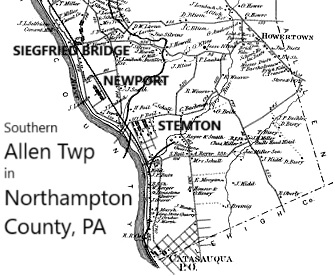 then later just
Siegfried. It was located between what is now 19th and 24th streets in current Northampton. then later just
Siegfried. It was located between what is now 19th and 24th streets in current Northampton. The second village was named Newport. In the 1820s, the Lehigh Coal and Navigation Canal was constructed alongside the Lehigh River. To unload the coal or the northbound goods, a new port was created along the banks of the canal and the Lehigh River. The name of the port and resulting village became Newport. It was a small village of less than 25 families for most of the 19th century until five cement plants would be built here. The third village was Stemton. It was created after the completion of the Lehigh & Susquehanna Railroad in 1867. It also ran alongside the Lehigh River on the east side of the canal. George and William Stem of Coplay moved across the river to construct the Lehigh Car Manufacturing Company, which made wooden cars for the new railroad line. This village was created along Main Street between what is now 5th and 10th Streets in the current Northampton. Under Pennsylvania law, they could become a borough if the three villages agreed to merge into one, which they did in 1902. Together they became the Borough of Alliance, as the town was an alliance made by the three villages. The name of the borough would be changed to Northampton in 1909. Humans Faced Extinction Nearly A Million Years Ago: Pre-humans might have gone extinct nearly 1 million years ago, with the worldwide breeding population hovering at only about 1,300 for more than 100,000 years, a new study published in Science finds. To learn about this period before the evolution of modern humans, scientists investigated the genomes of more than 3,150 present-day modern humans from 10 African populations and 40 non-African ones. They developed a new analytical tool called FitCoal to deduce the size of the group making up the ancestors of modern humans by looking at the diversity of the genetic sequences seen in their descendants. 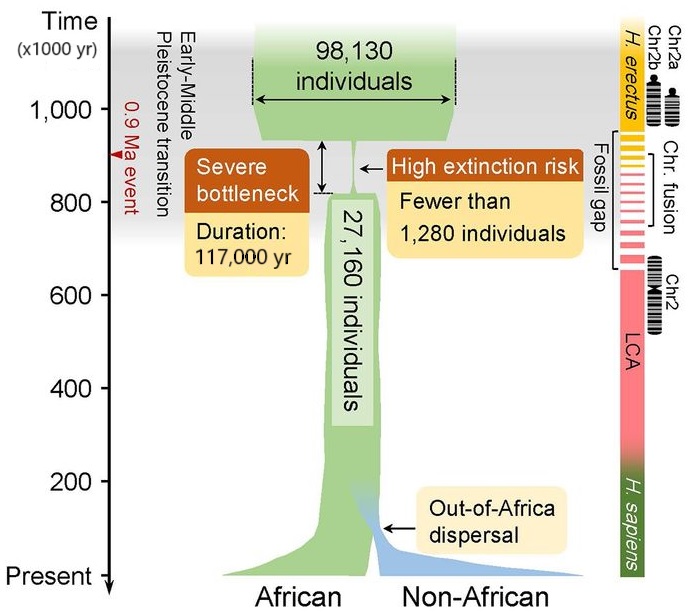 The
genetic data suggested that between 813,000 and 930,000 years ago, the ancestors of modern humans experienced a
severe "bottleneck," losing about 98.7% of their population. The researchers estimated that the pre-human breeding
population numbered only about 1,280 for about 117,000 years. [The article I read does not define "breeding
population," but I infer that 1,280 is the average number of distinct parental pairs during this era that would
have resulted in the observed genetic diversity in the modern humans they actually studied.] The
genetic data suggested that between 813,000 and 930,000 years ago, the ancestors of modern humans experienced a
severe "bottleneck," losing about 98.7% of their population. The researchers estimated that the pre-human breeding
population numbered only about 1,280 for about 117,000 years. [The article I read does not define "breeding
population," but I infer that 1,280 is the average number of distinct parental pairs during this era that would
have resulted in the observed genetic diversity in the modern humans they actually studied.]The scientists noted this population crash coincided with severe cooling that resulted in the emergence of glaciers, a drop in ocean surface temperatures, and perhaps long droughts in Africa and Eurasia. The event, known as the Transition of the Lower and Middle Pleistocene, was a turning point for many living things. Scientists still don't know how this climate change might have affected humans, because human fossils and artifacts are relatively sparse during this time, but the current study suggests that there are so few fossils and artifacts because the population was so low. It's generally accepted that, about 700,000 to 500,000 years ago, Neanderthals, Denisovans and an ancient version of us "modern humans" split from a common ancestor. That common ancestor may have been what scientists call Homo heidelbergensis, and this new study appears to support that theory. Previous research had suggested that modern humans originated about 300,000 years ago in Africa. But, with so few fossils around from that time, much remained uncertain about how the human lineage evolved before modern humans emerged. Still, Neanderthals and Denisovans are thought to have coexisted with early modern humans for nearly 300,000 years, before they went extinct around 40,000 years ago. All of this suggests that the near-eradication was potentially in some way linked to the evolution of the last common ancestor of modern humans, Neanderthals and Denisovans. Specifically, if this last common ancestor lived during or soon after the bottleneck, the bottleneck may have played a role in splitting ancient human groups into modern humans, Neanderthals and Denisovans. For instance, it might have split humans into tiny separate groups, and over time, differences between these groups would prove significant enough to divide these survivors into distinct populations—modern humans, Neanderthals and Denisovans. In addition, prior work suggested that about 900,000 to 740,000 years ago, two ancient chromosomes fused to form, in modern humans, what is currently known as chromosome 2. Neanderthals and Denisovans also share this fusion, so it must have occurred before the lineages split from each other. Since this coincides with the bottleneck, these new findings suggest the near-eradication of humans may have some link with this major change in the human genome, the researchers noted. "The fact that we are here today, populating this planet with over 8 billion individuals, means that we managed to survive myriad unfavorable events thanks to our adaptive abilities and, why not, a touch of luck," said Giorgio Manzi, professor of anthropology at Sapienza University of Rome. Manzi collaborated on the research. The findings still need to be tested against existing fossil and archaeological records. For instance, the researchers would like to find out whether those 1,280 survivors were indeed the ancestors of Neanderthals, Denisovans and modern humans. And with FitCoal, all they need is a little genetic information. Visit To Licko Lesce (by Joy Mims): I’ve written before about my search for my family in Europe. After identifying as Croatian for my entire life, I was shocked to learn that my family left Croatia in the 1600s and headed off to Hungary. When I learned that this area of Hungary became Burgenland, my search for family grew easier, as I speak German. But where did my Croatian roots originate? On a trip to Croatia in 2014, I visited the Croatian National Archives, more to see the beautiful building than to learn anything. Records didn’t go back that far and, in any event, I had no clue which records to search. It was quite a shock when one of our group, John, shouted out: “Hey, Joy! The Ostovic name is all over in the records for my village!” We had actually made a stop in that village, Licko Lesce, on our way to Zagreb. Could it be the village of my ancestors? Going forward to 2023, I had my DNA done by 23andMe. It narrowed my DNA directly to the area around Licko Lesce! I noticed that Bob Jerin, the leader of the Croatian-American group, 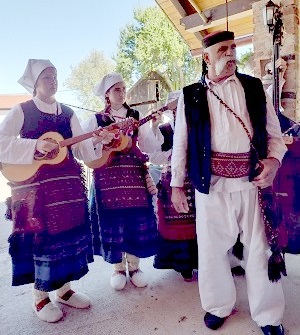 was
hosting another tour to Croatia and this tour was due to stop for lunch—guess where—Licko Lesce! I signed up and
my daughter decided to travel with me. We spent 2½ weeks exploring various islands on the Adriatic Sea and then
headed toward Zagreb by bus. was
hosting another tour to Croatia and this tour was due to stop for lunch—guess where—Licko Lesce! I signed up and
my daughter decided to travel with me. We spent 2½ weeks exploring various islands on the Adriatic Sea and then
headed toward Zagreb by bus. Licko Lesce is definitely not very large. We went to a restaurant that was located in an outside, open pavilion. Residents of the town were dressed in native costume and their local band played songs and danced while we ate. Homemade rakija was flowing. One little guy had his own bottle that he took a shot from between each song. My daughter said to me: “If anyone in this town is related to us, I bet it’s that guy.” I’m not sure what that says about our family! 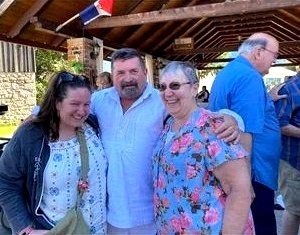 After
all was done, we went up to this fellow and told him my maiden name. The guy went bonkers! “Family, family,”
he shouted. He ran for the rakija bottle and poured us each a shot… and then another… shouting “family”
the whole time. He called over his nephew to celebrate with us. After
all was done, we went up to this fellow and told him my maiden name. The guy went bonkers! “Family, family,”
he shouted. He ran for the rakija bottle and poured us each a shot… and then another… shouting “family”
the whole time. He called over his nephew to celebrate with us. We are definitely not closely related after 350 years of living in different nations but it was very exciting to meet him and to learn that the name lives on in the village of Licko Lesce, Croatia! 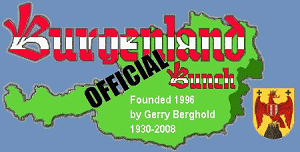 The
Facebook Bunch (from Vanessa Sandhu): The
Facebook Bunch (from Vanessa Sandhu):Greetings, Burgenland Bunch! We had a very busy month in our Facebook group. We welcomed 11 new members, bringing our roster up to 2093 friends! We had a lot of coverage of the Burgenland delegation visit to North America, as well as some great pics and videos from member Heidi Frank’s Burgenland trip! If you haven’t joined us, you can do so by clicking this link: facebook.com/groups/TheBurgenlandBunchOFFICIAL/ Member Fred Knarr shared a great video featuring the renovations at the beautiful Schloss Rotenturm: m.youtube.com/watch?si=xVoScMg5EbXMOydy. Fred also shared this lovely song called Eisenberger Lied 2023: https://youtu.be/Zy8KBxSJeIM. Our dear Fred also shared 25 photos of the gravesites at Rohrbach Cemetery, as well as 25 photos from the cemetery in Kotezicken. Member Bernhard Antal was kind enough to share the index he made cataloging the death records from St. Michael from 1794-1827. Many thanks, Bernhard! Member Martin Wolf informed us that the metrics of the parish of St. Martin at the Raab from 1700 on are now available online. In them you can find not only Catholic records but also Evangelical entries dating back to 1792. You can find it at http://matriken.at. BB Staff Member Patrick Kovacs shared a link with interesting historic pictures of Großpetersdorf: grosspetersdorf.at/750jahre/strassenausstellung. His paternal grandmother's hometown celebrated its 750th anniversary. New member Markus Gumbmann shared some nice photos from a trip to Oberwart that he took. Member Carol Hepp shared photos of some of the graves in Güssing. Member Brigitte Kurz shared over 200 photos of the gravesites in the cemetery in Eisenberg an der Pinka. She also shared over 50 photos of the memorials found at the cemetery in Höll. Thank you, Brigitte! Member Kathy Smith shared some great photos of her mom’s 101st birthday celebration! Brigitta was born in Oberloisdorf, Burgenland and emigrated to the USA in 1926. Her village was included in the festivities with a bottle of wine and the logo from the village. Happy Birthday, Brigitta! Member Heidi Frank took us all on a fantastic virtual trip as she traveled to Klingenbach, Rust am See, and Eisenstadt. The sights and sounds offered many of us a pleasant escape from the daily grind. She also visited the Museum of War for Peace in Trieste and took lots of interesting photos related to WW-I and WW-II. An update: member Ingrid Schuster’s Gedmatch Burgenland Bunch Ancestor group now have 214 kits! If you had your DNA tested and would like to have it added to our project, please let us know! As I mentioned earlier, we had the privilege of hosting the Burgenland Government Delegation in Coplay, PA, on October 20th. The delegation included Governor Hans Peter Doskozil, his wife, Julia, Leonhard Schneemann, Verena Dunst, Manfred Dunst, Christian Stiller, Manfred Riegler, Maria-Anna Slaby, and Paul Blaguss. BB President Tom Steichen was in attendance, as was BG staff member and BB Vice President, Klaus Gerger, and Vice President of the Burgenländische Gemeinschaft, Erwin Weinhofer. Also in attendance from the BB were BB staff members Bob Strauch, Zac Stubits, and myself. We had a fantastic time. It was great to see such a wonderful turnout from our Facebook family. Member Fred Knarr took lots of photos and videos to share with those who couldn’t attend in person. We are thrilled that the delegation was able to visit us, and hope to make these events more frequent in the future. A very special thanks to the Coplay Sängerbund and their phenomenal Heritage Committee. All of your hard work is appreciated by so many. Members Lisa Severin and Caroline Hepp shared lots of great photos from the delegation’s final stop in New York. The visit coincided with the 100th Anniversary celebration of the First Burgenländer Austria Social Club. Carol’s daughter, Felicia Borselio was Miss Burgenland NY 2023. Felicia’s good friend, Stefanie Weber, was crowned as the new Miss Burgenland NY for 2024. For those local to the Lehigh Valley in Pennsylvania: The Coplay Sängerbund’s Heritage Committee is hosting a Schnitzel Dinner on Saturday, November 18, 2023 from 5-7 pm. The cost is $18. Tickets are required. The meal includes: pork or chicken schnitzel (with or without jäger mushroom sauce), spätzle or mashed potatoes, apple sauce or red cabbage, a green salad, and a roll with butter. All proceeds benefit the Heritage Committee and their events. For tickets, please call Cathy Schanta at (610) 262-8372. The Coplay Sängerbund is located at 205 S. 5th Street, Coplay, PA, 18037. CONNECTIONS: Member Jan Harrison writes: “To all the people who are photographing gravesites, thank you. I am forever searching for Rosalia Mayer who died in Willersdorf about 1927-28, and my second-great-grandfather, Mihaly Jany, who lived in both Willersdorf and Unterwart during his life. He disappeared from records before 1940.” Also regarding gravesites, Member Leslie Makuh Herrick writes: “Any one taken photos of the Cemetery In Nagynarda? Family is mostly buried there and I would appreciate any photos.” If anyone has any pictures or helpful information for Jan or Leslie, please email me at HooftyRN@msn.com and I will be glad to connect you with them! Until next time, stay safe and healthy! Vanessa  Update
for book "The Burgenländer Emigration to America": Here is this month's update on purchases of the English
issue of the 3rd edition of Dr. Walter Dujmovits' book "Die Amerika-Wanderung Der Burgenländer." Update
for book "The Burgenländer Emigration to America": Here is this month's update on purchases of the English
issue of the 3rd edition of Dr. Walter Dujmovits' book "Die Amerika-Wanderung Der Burgenländer."Current total sales are 1744 copies, as interested people purchased 7 books during this past month. As always, the book is available for online purchase at a list price of $8.89 (which is the current production charge for the book, as we purposely choose not to make any profit so you can obtain the book at as low a cost as possible!), plus tax & shipping. See the BB homepage for a link to the information / ordering page and for information about current discounts (there is at least one discount on price or shipping available most of the time... if not, wait a few days and there will be one!). The book is an excellent read for the Burgenländers in your family. Burgenland Recipes: BB member Christine Rubba suggested a traditional recipe she ran across while recently visiting Burgenland. However, the one she sent uses some ingredients that may not be available in the US, so I substituted a recipe that I found at website A Feast For The Eyes for the same pastry with standard ingredients and English measurements (I tried converting the metric recipe she sent, but the quantities looked odd, and "pudding powder" is likely not the same as "instant pudding mix"). It should taste great anyway!  Buchteln
(Jam-Filled Sweet Austrian Yeast Buns) Buchteln
(Jam-Filled Sweet Austrian Yeast Buns)(courtesy of Debby, www.AFeastfortheEyes.net) Prep Time: 1 hour 15 minutes Cook Time: 30 minutes Dough Proofing Time: 1 hour Total Time: 3 hours 45 minutes Servings: 12 rolls Calories: 362 kcal Ingredients:
For the bottom of the baking pan:
Preparation:
Stand-Mixer Directions:
Notes from Debby:
William Kent Krueger, 2023 |
|
3) HISTORICAL BB NEWSLETTER ARTICLES Editor: This is part of our series designed to recycle interesting articles from the BB Newsletter of 10 years ago. This time, while I pick an article from the October 2013 newsletter of 10 years ago, it is really a two-for-one selection. The first part of Article 4 in that newsletter could be presented again as an independent article that is well worth sharing totally on its own merits. However, I originally entangled it with a tidbit in Article 1 and a follow-up after the body of Article 4, as those components illustrated what Article 4 taught. I will do so again but will pare down the tidbit to only what is necessary to introduce the follow-up and will place everything after the body of Article 4. Here goes. THE BURGENLAND BUNCH NEWS No. 236 October 31, 2013 THE RIGHT OF DOMICILE Margaret Kaiser passed along a (German language) question and answer, found on the "GenTeam Austria" mailing list, that she felt was applicable to our understanding of Burgenland records and that also contained a couple of links worth noting. In particular, a GenTeam Austria list member (Frank Fleissner) wrote that he found a phrase in a birth entry (in a church book from the Bohemian Forest area along the national border of the Czech Republic with Germany and Austria) that he needed help in understanding. The phrase was "dahin zuständig" and it appeared next to the birth mother's name in the entries for illegitimate births. I'll note that the phrase translates to "there responsible" or "to that place responsible." The reply message (by Martin Aigner) concentrated only on the word "zuständig" and the meaning of "responsible" in this context. Martin wrote (in part) that "responsible" meant that "the mother had the right of domicile in the village" and, therefore, that the community of birth was also responsible for recording this illegitimate birth in its register. Further, Martin explained that "Marital children acquire the right of residence in that municipality in which the father held home rights at the time of their birth," However, "illegitimate children are entitled to home rights in the community in which the mother has the right of domicile at the time of their birth." Martin also noted that "Therefore, it was quite possible that people were born in places where they did not have the right of residence and therefore the birth entry is not found in the local book of births, but in the place where the parents had the right of domicile." He also indicated one could read more at: http://www.demokratiezentrum.org/wissen/timelines/entwicklung-der-staatsbuergerschaft.html http://de.wikipedia.org/wiki/Österreichische_Staatsbürgerschaft Both of the above are German-language websites. The first is titled "Development of Citizenship in Austria" and gives a timeline history of citizenship rights and the related "home rights" / "right of domicile" in Austria and the prior Austro-Hungarian Empire. The second, titled "Austrian Citizenship," concentrates mostly on post-1984 citizenship regulations, with only a short historical section. Given our interest in the older, historical rules, I'll provide a summary of the material from the first link only. In addition, although this first webpage addresses citizenship regulations into the current day, I will stop my summary at 1925, as the WW-II Anschluss-induced changes and later restitutions and additions are complex and largely inapplicable to our emigrant forebears. Here is what the first webpage says: 1786: In Emperor Joseph II's law books (patent of November 1, 1786) there appears, for the first time, a distinction between "subjects" and "strangers". 1804: The Conscription and Recruitment patent of 25 October speaks of "locals" and "foreigners" (with regard to the preservation of the army). This law forms the initial basis for later law provisions concerning homeland and community affiliation. 1812: For the first time in the Civil Code there is a uniform regulation that includes the term "citizenship" but is, by no means, a citizenship law in the strict sense. Although it applies to all "German dominions" of the monarchy, the meaning of citizenship is limited. Instead, it is closely linked with regulations regarding emigration and is considered a precondition for obtaining the "home right" in the community, which is of far greater importance. 1849: The provisional Community Law forms the basis for subsequent regulation of Homeland rights. A distinction is made between "community members" and "strangers," wherein community members are either citizens or dependents and relatives of those citizens. However, all who are recognized (by birth or admission to the municipality by the local authorities) as current or permanent residents or property owners "...shall pay a certain amount per year in direct taxes." 1859: Municipalities Act of 1859 includes, for the first time, the term "Heimatrecht" (home rights / right of domicile / right to residency). 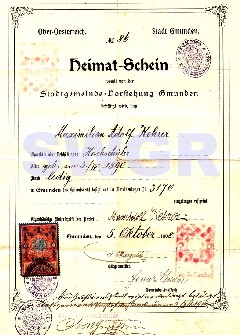 1863:
In the Heimatrechtsgesetz (Home Rights Act), the home town is declared responsible for keeping a record of
community members (a "home roll") and for the issuance of home rights certificates (Heimatschein:
certificate of origin). People who were not already registered in the membership of a Catholic parish (Pfarrmatrikel),
were recorded in a civil register (Zivilmatrik) in 1870. Home rights (right of domicile) is based on
the principle of descent and can be obtained only by Austrian citizens. The Act declares that every citizen
shall have the right of domicile in an Austrian community, the right to an undisturbed stay in the home community,
and community poverty relief (the Act was also the precursor to a formal right to vote). Further, home
rights are acquired by birth, marriage, admission to the home association or public office, and by "adverse
possession" (living in a Crownland for at least ten years [and later four years]). It is also noted therein
that women gain through marriage a right of domicile/citizenship in the home community of her spouse. This is also
the Law that Martin Aigner cites above concerning the differing home rights for legitimate and illegitimate
children. 1863:
In the Heimatrechtsgesetz (Home Rights Act), the home town is declared responsible for keeping a record of
community members (a "home roll") and for the issuance of home rights certificates (Heimatschein:
certificate of origin). People who were not already registered in the membership of a Catholic parish (Pfarrmatrikel),
were recorded in a civil register (Zivilmatrik) in 1870. Home rights (right of domicile) is based on
the principle of descent and can be obtained only by Austrian citizens. The Act declares that every citizen
shall have the right of domicile in an Austrian community, the right to an undisturbed stay in the home community,
and community poverty relief (the Act was also the precursor to a formal right to vote). Further, home
rights are acquired by birth, marriage, admission to the home association or public office, and by "adverse
possession" (living in a Crownland for at least ten years [and later four years]). It is also noted therein
that women gain through marriage a right of domicile/citizenship in the home community of her spouse. This is also
the Law that Martin Aigner cites above concerning the differing home rights for legitimate and illegitimate
children.1867: The Basic Law is the first constitutional law governing questions of citizenship. The three main provisions are that 1) for all people in the Imperial kingdoms and countries, there is a general Austrian citizenship law; 2) that before the law, all citizens are equal; and 3) that public offices are equally accessible to all citizens. However, for foreigners, such rights are dependent upon acquisition of Austrian citizenship. 1869: A minimum of ten years of residence and possession of citizenship is a condition for receiving a "right of domicile". 1918: After the collapse of the Austro-Hungarian Empire, the German-Austrian Republic is proclaimed with a provisional constitution and on 5 December 1918, a corresponding German-Austrian citizenship law is promulgated that says that all persons who were entitled to home rights in a community that is now in the German-Austrian Republic are immediately awarded German-Austrian citizenship and rights. In addition, people who were resident in Vienna since 1914, can apply for and obtain citizenship. Further, refugees who had home rights in Austrian areas not in the new German-Austrian Republic and, therefore, lost their prior Austrian citizenship, also can (during a one-year period) apply for and obtain citizenship. (This last provision sparked verbal outbursts, especially against allowing citizenship to Jewish war refugees.) 1920: The Austrian Federal Constitution is adopted, with citizenship legislation being a federal matter and implementation a state matter. There are both a federal and a state citizenship, with the prerequisite being home rights in a community in the country. 1925: With the Right of Domicile amendment in 1925, control of such rights are transferred to the federal constitution. 1925: The citizenship law is enacted, regulating both state and federal citizenship. Citizenship is acquired by birth, by ceremony with a minimum of four years' residence, by marriage (married women automatically get citizenship as "appendages" of their husbands) and by the start of a public teaching job in a domestic university. So, much as Fritz Königshofer has been trying to teach us, this "right of domicile" was an important right, was well-regulated, and conferred many privileges. Establishing a record of the right was essential and valuable. As you can see however, the place of birth was not the controlling factor in where a child held rights. Rather, the place where the relevant parent had rights determined where a child held rights. Likewise, the location for home rights of a wife was determined by those of the husband. Be sure to keep these rules in mind when you search for the location recording a birth or marriage. Editor: It is here that I combine the tidbit of Article 1 with the original follow-up to the above. Both are slightly edited to improve the flow and eliminate unneeded information. Gilly Surname in Burgenland: Meanwhile, the BB staff was helping Peter Bach work through some of his family history, which involved his grandmother, Caecilia Gibiser, born 1885 in Kukmirn. Peter had an official extract (dated 1900) from the Kukmirn birth register that showed she was born illegitimate, but then officially legitimized when her natural father, Ferencz Gibiser, married her mother in 1887. Interestingly, the mother's name was Teréz Gilly from Zahling. We didn't know that at first because the English translation Peter had done for him showed her last name as Tilly. Peter suspected Tilly was wrong, so he both checked the German document and sent a copy to me; we both read it clearly as Gilly, not Tilly. I wrote to Peter (in part):
|
|
4) ETHNIC EVENTS LEHIGH VALLEY, PA Friday, November 3: The Alpenländers at the Lancaster Liederkranz. Info: www.lancasterliederkranz.com Saturday, November 4: Button Box Night at the Ss. Peter & Paul Society in Northampton (Hungarian Hall). Music by Josef Kroboth and the Button Box Committee. Info: www.facebook.com/p/Northampton-Hungarian-Club-100063563233868/ Sunday, November 5: Josef Kroboth Orchestra at the Coplay Sängerbund (Country-Western Dance). Info: www.coplaysaengerbund.com Sunday, November 5: Reading Liederkranz Singers at Zion Moselem Lutheran Church in Kutztown. Info: zionmoselemlutheranchurch.weebly.com/tannenberg-concert-w-mark-herr-the-liederkranz-singers-orin-strunk-and-glenn-fisher.html Friday, November 10: St. Martin's Day Festival at the Lancaster Liederkranz. Info: www.lancasterliederkranz.com Friday, November 10: Kermit Ohlinger at the Reading Liederkranz. Info: www.readingliederkranz.com Sunday, November 12: Emil Schanta Band at the Coplay Sängerbund. Info: www.coplaysaengerbund.com Friday, November 17: Josef Kroboth Orchestra at the Evergreen Heimatbund in Fleetwood: Info: www.evergreenclub.org Sunday, November 19: Dave Betz Band at the Coplay Sängerbund. Info: www.coplaysaengerbund.com Friday, November 24: Kermit Ohlinger at the Reading Liederkranz. Info: www.readingliederkranz.com Sunday, November 26: Maria & John at the Coplay Sängerbund. Info: www.coplaysaengerbund.com NEW BRITAIN, CT Friday-Sunday, 1-8 pm: Biergarten is open. Austrian Donau Club, 545 Arch Street. ST. LOUIS, MO Sunday, Nov 5, 1-5 pm: St. Louis Burgenländer Gathering at the Community Center Cafeteria of Holy Name of Jesus Catholic Church, 10235 Ashbrook Dr, St. Louis, MO. Contact: tmacwms@sbcglobal.net UPPER MIDWEST (none) |
|
5) BURGENLAND EMIGRANT OBITUARIES Emilia Duncan (née Gratzl)  Emilia Duncan, age 93, of
Lemont, Illinois, at rest on October 20, 2023. Emilia Duncan, age 93, of
Lemont, Illinois, at rest on October 20, 2023.Devoted wife of the late Melvin for 68 years. Dear Mother of Susan (David) Harrison and David (Sharon) Duncan. Proud Grandma of Tim (Vanessa) Duncan, Amy (Matt) Flynn, Ryan (Natalie) Duncan, David (Tess) Harrison and Stephanie Childs. Loving Great Grandmother to Raegan and Garrett Duncan, Grady Flynn, Madeline Childs and Mila Duncan. Born in Pornóapáti (Pernau), Hungary to Johann and Rosa (Unger) Gratzl. She was deported with her family from their home during the Russian Occupation of their beloved village. She came to the United States with her parents and her late brother Emerich (late Irmgard) as a teenager. Settling in Chicago, where she met and married Mel. They raised their children on the Southside of Chicago. Emilia (Millie) was a member of the Bakers Union retiring after over 35 years with Dressels Bakery. She was proud of her work ethic, decorating ability, and quick skills on the line. There were always some delicious treats in the family refrigerator with extra filling added by Mom. She will be lovingly remembered for her tasty home baked cookies, that were the highlight of any and all family celebrations. She also loved having her family gathered at the table for one of her delicious dinners. It was difficult to keep her sitting there for long, jumping up to warm up the gravy or get extra food. She would tell everyone at the table, if you need something “Just Holla” (holler). The grandkids loved to tease her and she laughed as they all would “Holla”. Her feisty, strong personality and hard work ethic were evident in all areas of her life. Her family will miss her “I love you’s”, laugh, spirit, and of course, her cookies. The grandchildren gave her so much joy. She was proud to share in all their life moments. She was fortunate to have the time on earth to know her great grandchildren. Her love for them was so evident in her smile as she posed for pictures and held them close. Gifted with a long, healthy life she now lives forever with the Lord. She was so looking forward to being united with her Mel for eternity. Memorial Visitation Monday, October 30, 2023 from 10:30-11:30 until time of Mass at 11:30 am at Franciscan Village Chapel 1270 Franciscan Drive, Lemont ,Illinois. Internment will be at a later date at Abraham Lincoln National Cemetery. |
|
| END OF NEWSLETTER (Even good things must end!) |
|
|
Burgenland Bunch Newsletter, copyright © 2023 by The Burgenland Bunch |
 News
News